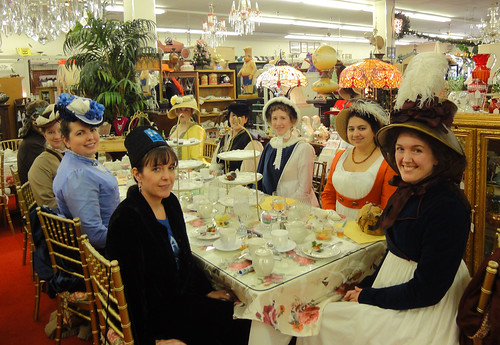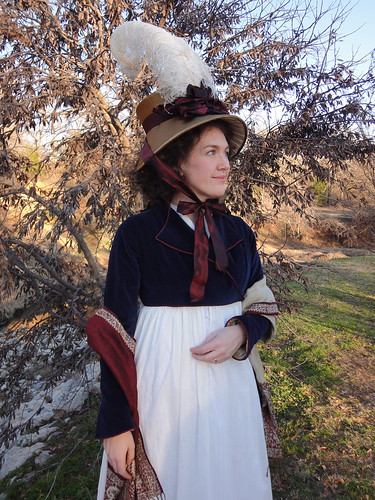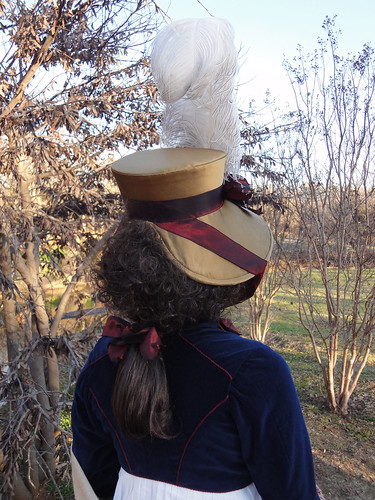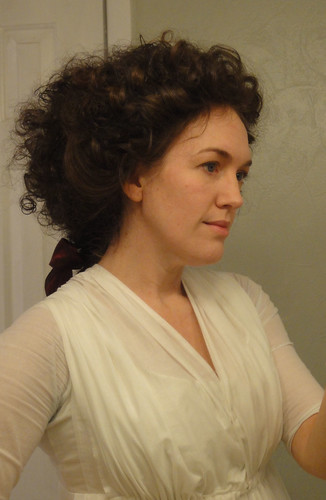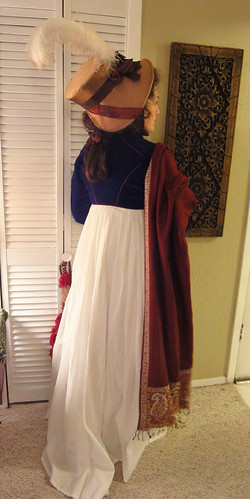Yesterday was the DFWCG's Mat Hatters Tea Party, so I wanted an appropriately flamboyant hat (and new costume to wear with it) to celebrate the event. I've spent the past 2 months angsting about what to make, and I think I started working on at least 3 or 4 other possibilities before I finally settled on a simple 1790's spencer and bonnet. But I ended up loving the final outfit so much that now I can't imagine wearing anything else!
To save time, I focused on making something new to dress up my round gown that I made for the Georgian Picnic in November. I didn't know a lot about Empire spencers, so I started by creating a
Pinterest board of all the 1790's examples that I could find. I was amazed by how many dark blue spencers there were in the illustrations, so I went digging through my stash and found a dark blue velveteen curtain panel that I picked up at an estate sale last year. It was just enough fabric for a spencer, so I decided that it must be fate! It is lined with some golden yellow striped silk that also came from my stash, and I even found some burgundy cording in my bin of ribbons that was perfect for accenting the
edges and
back seams like you see in many of the jackets from this period.
I usually have some sort of period pattern diagram to get me started with my costumes, but this garment was 100% draped from scratch. I knew where the seams should be thanks to the illustrations and a few surviving examples, so I used one of my paper tape dress forms to drape the body and collar. I did look at a pattern diagram for an 1790's youth's skeleton suit to get the general shape for the 2-part curved sleeves, but then I just free drew the shapes and tweaked them for a few days until I got something that fit just right. I know it is not an overly complicated garment to make, and there are still a few nit-picky things that could be improved, but I am really proud of the results considering that this was the first time for me to make something using this method.
The most fun part of this outfit is definitely the hat. Once again, I made a Pinterest board to help me research
1790's bonnets, which was extremely helpful when it came down to deciding on the shape and adding the decorations. I found
several examples of wide brimmed bonnets with a big bow and super-tall feathers decorating the middle front of the crown, and I thought that look really captured the quirky Empire style that set these fashions apart from other Regency period headwear.
The bonnet also marks another first for me - it's the first time I've ever built a fabric-covered buckram hat. I used Lynn McMaster's
seaside bonnet pattern to make it, but I cut the crown down by an inch because I preferred some of the more moderate-sized examples in the fashion plates. It is covered in a remnant of bronze silk satin and lined with ivory silk, which also both came from my stash. I sewed the entire thing by hand and there is not a drop of hot glue on it, which is a small miracle for me. I am usually a HUGE fan of hot glue millinery!
Since the costume was made completely from materials that I had in my stash, I decided to splurge a bit on the finishing touches. I bought another
Lioness wig in chestnut brown this time (I also used this style of wig for another
18th c. outfit from a few years ago). It is great for making a huge hedgehog style hairdo and there is a ton of length for various types of tails in the back as well. This time I straightened the long part in the back with a flat iron and looped it like the style seen in many
illustrations from this period. I had some flyaway pieces that tried to escape from the ponytail at first, but I added a long flat barrette across the back of the loop after these first pictures, and that seemed to solve the problem pretty well.
I also have lusted over regency shawls for years now, so I asked around for suggestions on where to buy one. My friend Aubry from
A Fractured Fairytale suggested
this ebay store, which has a variety of rectangular shawls with paisley borders, which is exactly what I was looking for. It still wasn't as long as real regency shawls should be, but at $19.99 I couldn't pass it up! I actually ended up loving this thing so much that I bought a second one that is exactly the same, and I am going to try to sew two of them together to make one super-long shawl that will be even more perfect for
drapey Regency goodness.
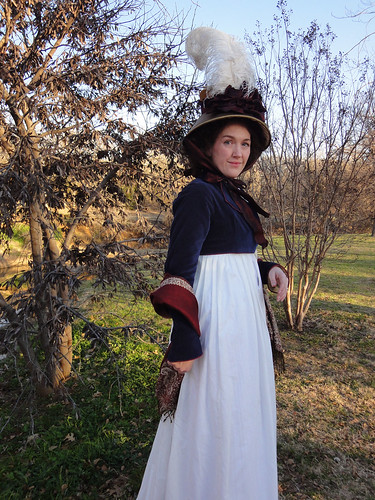
When I was younger, I didn't care for Regency fashions at all, and I swore that I would never wear this sort of dress. I'm not sure what happened, but I've turned into a complete convert and I feel so elegant wearing these styles now. Maybe I just needed to get over my obsession with tiny waistlines first, but I guess pregnancy will do that for you.
Even though I'm making a bit of a funny face in this last picture, it's actually my favorite one of all. I think I look like a meddling, match-making aunt from a Jane Austen novel in this shot. I need a little speech bubble that says "oh, ree-aaally?" LOL!
You can see the full set of pictures from this wonderfully fun event on my
Flickr page.




